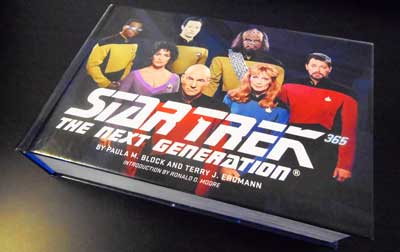THE UNFETTERED CRITIC
Revisiting The Final Frontier: Star Trek: The Next Generation at 25
by Paula Block Erdmann & Terry Erdmann
Let’s turn the clock back a few decades.
 A long time ago in a galaxy far, far away…
A long time ago in a galaxy far, far away…
No… wait. That’s that other space saga, the one that we’re not associated with.
Many of you know that we make part of our living writing books about Star Trek. More often than not, however, when our friends introduce us to new friends, they state, “Paula and Terry write Star Wars books.”
Not that that would be a bad thing; it’s just incorrect. And so we smile and say, “Well, actually…”
The thing is, the only similarities between Star Trek and Star Wars are that both are set in outer space, and both have the word “Star” in the title. Star Wars is based on swashbuckling fantasy—think light saber duels between characters that wield a magical “Force.” Star Trek is based on science—actual science that, although seemingly futuristic, often becomes reality in our world. Think “communicators” and “PADDs.” We doubt that the Force ever will be as practical as the communicator you now carry around in your pocket or purse, or the PADD (tablet computer) that you now read and write and do your taxes on.
But we digress.
Now let’s turn back that clock we mentioned above.
Between 1969 and 1987, new episodes of Star Trek were absent from the small screen. But through the miracle of syndication, reruns of the show amassed a huge following. Paramount Pictures took notice of this phenomenon and began churning out very profitable Star Trek motion pictures. Then someone at Paramount realized that they could take in even more profits if they also produced a new Star Trek television series.
And so in ’87, Star Trek: The Next Generation hit the airwaves—and became an instant hit. We probably don’t need to tell you what the show was about. Brave captain, loyal crew, bizarre space aliens, cool space ships, and a noble mission to explore “the final frontier.” Plus, of course, hip, futuristic science (including that wonderful PADD, acknowledged by everyone as the inspiration for Apple’s iPad).
Shortly after that, we started writing books about the Star Trek franchise. Two years ago, one of those books—written right here in Jacksonville, by the way—sold so well that our publisher offered us a plum assignment: write a book to celebrate the 25th anniversary of this second series. It would be called Star Trek: The Next Generation 365.
While we were working on the book, the studio began converting the 178 episodes of Star Trek: The Next Generation to pristine Blu-ray format, perfect for your HD television set. It wasn’t a simple process. TNG’s groundbreaking visual effects had been created with a 1980s video process that saved the production a ton of money—but it meant that effects were too “grainy” for big screen HD viewing. The 25th anniversary offered incentive to recreate those effects—despite the great expense involved. The technicians’ task would be to match the original effects as closely as possible, making each shot sharper and clearer, capable of standing up to the exacting standards of today’s tech-savvy audiences.
We’ve seen episodes in the remastered Blu-ray format, and agree that it was well worth the investment. The episodes look glorious. If you enjoyed The Next Generation as it originally aired, you’ll be gobstruck by the Blu-ray version. And if you’ve never watched it, what are you waiting for?
Meanwhile, keep an eye out for Star Trek: The Next Generation 365, set in space but written in J’Ville, when it appears in your local bookstore on October 1st.
Just don’t ask for Star Wars. Please?
Paula and Terry each have long impressive-sounding resumes implying that they are battle-scarred veterans of life within the Hollywood studios. They’re now happily relaxed into Jacksonville.

 Paula and Terry identify as writers, with an ever-increasing number of published works to support the supposition. They live a primarily pastoral life in the enchanted town of Jacksonville.
Paula and Terry identify as writers, with an ever-increasing number of published works to support the supposition. They live a primarily pastoral life in the enchanted town of Jacksonville.